Homestyle Mashed Potatoes
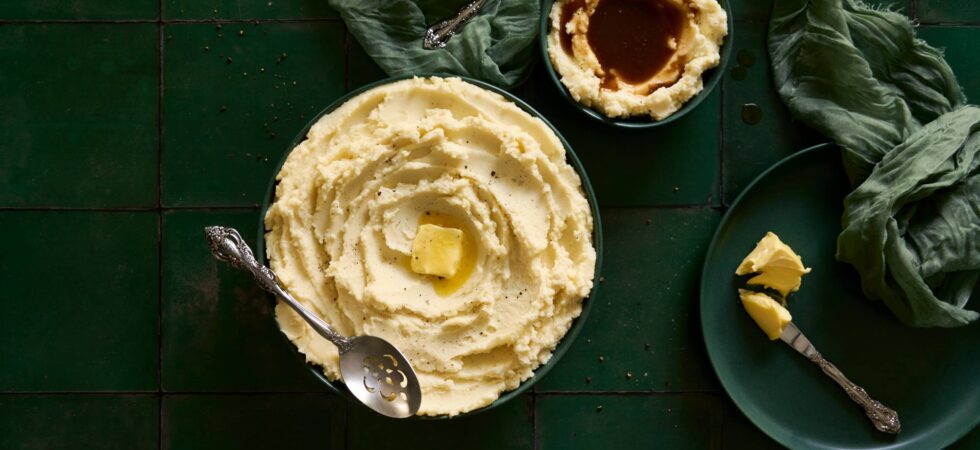
Everyone says homestyle mashed potatoes are super easy to make and yet it took me years to get consistently creamy, buttery mashed potatoes. Why? Because there is a LOT going on in terms of technique and food science.
So, forgive yourself for all of those failed attempts, where you literally did the SAME THING, and your mashed potatoes turned out lumpy or gummy. In this post, I’ve answered every question I could think of about flavor, texture, and technique. Let’s move forward, what do you say?
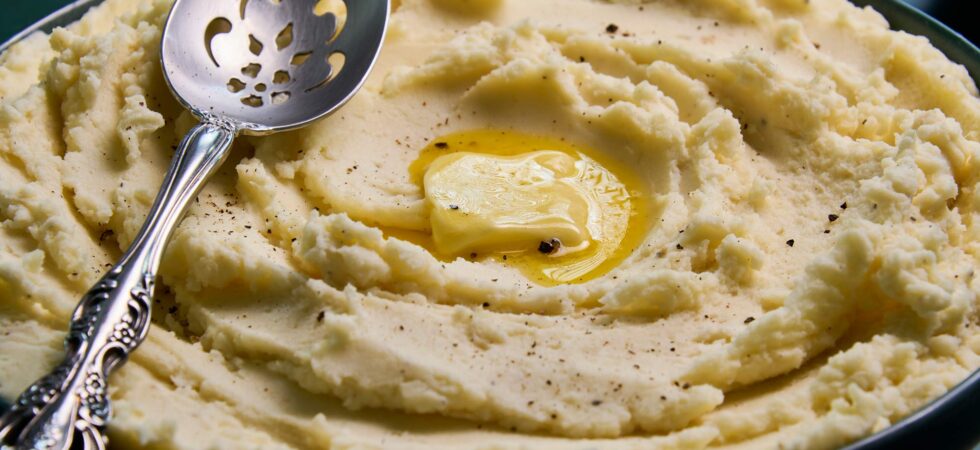
Get the Recipe: Homestyle Mashed Potatoes
Ingredients
- 8 cups water
- 1½ + 1 teaspoon Diamond Crystal kosher salt, divided as written
- 2½ lbs russet potatoes, (about 5-7 medium potatoes)
- 8 tablespoons (½ cup) European-style butter
- ¾ cup sour cream
- 2 tablespoons whole milk
- ¼ teaspoon fresh ground black pepper
Equipment
- 1 large pot
- measuring Cups
- Measuring spoons
- kitchen scale
- 1 peeler optional
- 1 chef knife
- 1 cutting board
- 1 colander
- 1 spatula
Instructions
- Begin by filling a medium pot with 8 cups of tap temperature water and 1½ teaspoons of kosher salt. Next, peel, rinse, and cut the potatoes into roughly the same-sized large pieces. They shouldn't be smaller than 2-inch (5cm) cubes. (see FAQs about how potato piece sizes affect texture/flavor).
- Add them to the pot and bring the pot to a very gentle boil on your stovetop. You should see foam build up on the top of the water, but the water's surface shouldn't look like it's doing more than shifting a little. It’s okay to allow some bubbles while boiling but keep them gentle. You don’t want the potatoes moving around too much in the water or they will rub against each other and break apart before the centers can cook all the way through. Boil for between 30-45 minutes, until a fork slides into the center of the largest piece(s) without resistance (See FAQ for a more thorough description of doneness)
- Once ready, drain the pot of potatoes over a colander. Give the potatoes 1-2 minutes to let off some steam. Then, using tongs to transfer the hot pieces of potato, push everything through a potato ricer back into the empty pot. Return the pot to the stovetop and turn the burner on warm/low. Let the potatoes sit for another 3-5 minutes to allow them to steam and dry out even more. To help release moisture, use a fork to gently fluff the potatoes every minute or so.
- At this point, add just the butter. (Why just butter? See the FAQs!) Use a spatula to gently fold the potatoes around until the butter is completely melted. Then, add the rest of the salt, the pepper, and the sour cream. Fold again, until the sour cream is mostly incorporated and then mix in the milk, to thin everything out. Taste your homestyle mashed potatoes and add any additional salt, if needed.
Notes
- Leftover potatoes can be stored for up to 4 days in the refrigerator.
- This recipe makes about 3.5-4 cups of mashed potatoes and will serve up to 8 people. Most people will eat about 1/2 cup (120 ml by volume) of mashed potatoes with a meal. So, consider this at your next holiday party or Sunday dinner.
- Here’s a quick breakdown on potato sizes from typical 5lb (2.3kg) grocery store bulk bags: small potato .22lbs (98 gm); medium potato .35 lb (165 gm); large potato .4 lb (175 gm). This does NOT count towards membership bulk warehouses, like Costco. Those potatoes are bigger than my face!
- For a gravy recipe, check out my Dry-Brined, Reverse-Seared Prime Rib recipe for the Au Jus portion of the post. Just scroll past the Prime Rib for the Au Jus and gravy notes.
Nutrition

Frequently Asked Questions
There are two types of potato that are used in mashed potatoes Yukon Gold and Russet. I prefer to use russet and made this recipe based on that variety. But let me give you more information on each, so you can decide which are best for you.
Russet: This potato is low in moisture and high in starch. They produce a lighter, fluffier mash and are great at absorbing whatever wet ingredients you add to them. They also have a stronger potato flavor than Yukon golds. The downside? You have to be careful when mashing them because their high starch content can cause then to go gummy quickly.
Yukon Gold: This potato has less starch and more moisture, so they are more forgiving than russets when mashing and mixing in ingredients. In fact, they need a lower ratio of wet ingredients to potato than russets to make a creamy texture. I suppose, this makes them a healthier option as well! Yukon golds have a buttery flavor and slightly waxy texture that help them create a denser mashed potato. Their density makes them a better option for potato salads than mashed potatoes IMO. But that’s just because I LOVE a fluffy, light mash. And these hold up better after boiling than russets.
Visually: Russets will develop a starchy, sandy appearance on their outsides as they cook. Typically, the outside of the potato pieces will slough off a bit if you move them around the pot. They should not completely fall apart.
Physically: Russets are done when you can slide a fork into the largest pieces, and it doesn’t meet any resistance. Resistance will feel like you are scraping your fork against plastic. Your fork might stutter a bit as it goes into the potato or hit a hard patch. You should not have to alter the pressure of your fork against the potato to get further into the potato piece. It doesn’t matter if you are at the surface or center, it should all feel the same. This does not mean the potatoes are falling fully apart.
If a piece of potato splits away from the larger piece very easily, especially if you are dead center, skewer 2 more large pieces to confirm doneness and immediately drain the potatoes. If there is a lot of accompanying starchy pieces separating while straining, the potatoes are likely a bit over-cooked and water-logged. Don’t panic. There is quite a bit of overcooking that can be overcome. It’s not over, until it’s over!
If you over cook your potatoes two things have happened, internally and externally.
1. Internally: Starch granules in the potatoes swell excessively or even burst, allowing water to permeate the potato. This causes a waterlogged or mealy texture.
2. Externally: A lot of the starches, nutrients, and flavor from the potatoes will permeate the water. This loss can’t be added back into the potato. And the resulting mashed potatoes will be less flavorful and creamy.
TIP: Unfortunately, there’s nothing that can really be done about the flavor or nutrients. However, keeping the riced (We will get to this in a later question) potatoes on your warm stove top longer can help dry out the potatoes and combat the additional moisture. Every few minutes, use a fork to gently fluff the potatoes, releasing trapped moisture from inside the mound of potato pulp. The potatoes won’t be as creamy as they could be, but they can still be good if you get enough water out.
You can do this if you are desperate and rushing but I would not recommend it. Why? Mostly flavor.
The more surface area (from the potatoes) touching the water, the more all of the external issues (described above) happen. Internally, as long as you don’t over-cook the potato pieces, the starch molecules will remain intact. You can expect more moisture in general because there is more surface for water to cling to when straining, but it shouldn’t be something that can’t easily dry out in the colander and on the stovetop. So, you can expect less flavor and nutrients in your final mashed potatoes, but the texture should still be good-to-go.
This is actually the best way to make mashed potatoes. But there are extra steps, it takes longer, and you’ll probably need 15-20% more butter, sour cream, and milk, which feels less accessible.
Want instructions? Why not! If you want the most potato-y, fluffy mashed potatoes:
1. Find potatoes that are all relatively the same size in diameter and length. Give them a thorough scrub and rinse. Then, shallowly score the potatoes along their equator with a paring knife, before adding them to the pot of salted water.
2. Follow the boiling instructions as written. The timing will likely increase to over an hour, and you will lose the visual starchiness present with peeled potatoes. However, the fork test will be exactly the same.
3. Near the end of boiling, fill a large bowl of ice water. When ready, use tongs to move the potatoes into the bowl of ice water and shock the cooked potatoes for 3-5 minutes. This should loosen the peel and make them cooler to handle. Empty the pot of water and return it to the stove. Then, peel the potatoes by grasping the potato on either side of your cut and twisting your hands in opposite directions. Once the skin moves, slide them off.
TIP: if the peel is stubborn, you can take it off in strips with your fingers or the paring knife.
4. Break up the potatoes and use a ricer to mash them back into the pot. Again, follow instructions as written until your homestyle mashed potatoes are done. If you need additional creaminess, add more butter. For more fluffiness, add more sour cream. If both of those are good, but the potatoes are too dry or thick, add milk. Salt, the taste. FIN!
The gumminess in mashed potatoes is caused when the cellular structure of the potatoes’ starch molecules is broken down too much. When starch molecules combine with hot water molecules, it creates a gel. The more homogenized (blended to uniformity) the more gelatinization. Et Voilà, gummy mashed potatoes.
The best way to get the smoothest texture is to use one or more of these tools: a food mill; a potato ricer; or a tamis (drum sieve/flat fine mesh strainer).
I use only the ricer in this recipe for accessibility purposes but using a combination of either a food mill or ricer and then pushing the riced/milled potatoes through the flat sieve will make the smoothest possible mashed potatoes. These tools break apart the pieces of potato while aerating them at the same time.
Other tools, like your trusty hand beater/mixer or potato masher do both of these, yes. But they do both poorly. I have never, in all of my years of making mashed potatoes, had a fully smooth mash after using either of these tools. Close, yes! But not all of the way. Additionally, the constant agitation created during mixing first aerates and then compresses the potatoes. And that compression costs you your fluffy final texture.
The ricer and food mill break the potato up only once and then you can literally fold the rest of the ingredients in with minimal agitation. Trust me, it’s worth it.
There are a bunch of reasons to add butter to your freshly mashed potatoes before adding in any other ingredients like milk, cream, sour cream, cream cheese, buttermilk, etc.
1. Melting and incorporation: this is probably the easiest one to guess. If you cool down your potatoes with milk or other liquids and then add in the butter, it isn’t going to incorporate into the mashed potatoes as well. If you want butter to fully coat and absorb into your potatoes uniformly, add it when they are still hot and nothing else is there to get in its way.
2. Flavor: Speaking of butter absorbing into potatoes, that is a great way to flavor your potatoes. And what better way to spread that butter to every granule of potato than melting and mixing it in before anything else.
3. Emulsification: Butter has natural emulsifiers that help the milk and sour cream hold and mix with the potatoes better. This leads to a better, smoother textured result.
4. Starch protection: The fat in the butter wraps itself around the starch molecules in the potatoes. This layer of fat then protects the starches and slows their breakdown as you fold in the other ingredients. This doesn’t completely prevent gumminess in your mashed potatoes, but it does provide some additional tolerance you wouldn’t have otherwise.
Place unused mashed potatoes into a lidded container and then directly into a refrigerator. Do NOT leave your hot, lidded mashed potatoes out on your counter for more than an hour at room temperature.
Why? The real ones know that potatoes can low key be dangerous if not stored properly. Those buffets with tin foil wrapped baked potatoes sitting out all day are a BIG NOPE.
Botulism is caused by Clostridium botulinum, a bacterium that produces toxins in low-oxygen, low-acid environments. Potatoes, especially when wrapped in foil or stored in airtight containers, can create an anaerobic (low-oxygen) environment that allows the bacteria to grow if they remain at unsafe food temperatures, between 40–140°F (4.4–60°C), for too long. Botulism spores and bacteria don’t die until they hit 250°F (121°C) for at least 20 minutes, so there’s no easy way to reheat your mashed potatoes to the correct temperature.
Long story short, if they sit out to long, just toss them.
I’ll either reheat them on the stove top or in the microwave.
1. Stovetop: Place the mashed potatoes in a wide saucepan or large pot. Turn the burner on to medium-low/low and add in 1-2 tablespoons (14-28g) of butter. Move the potatoes around so they don’t stick to the bottom as the butter melts. Add a bit of cream or milk if they get a little too thick or stiff. Warm all of the way through and serve.
2. Microwave: Reheat mashed potatoes in a microwave safe container somewhere between 30-50% power over 5-10 minutes. Mix the potatoes around with a spoon every minute to make sure nothing is heated unevenly. When they start to get warm, you can add in a bit of butter and maybe some cream.
Why so low and slow? Microwaves agitate the water within molecules to create heat. If you re-heat the potatoes at too high a power, rapid evaporation can occur, which may dry out the potatoes and result in a crumbly or grainy texture. Excessive heat can also breakdown the starch molecules in the potatoes completely and give you that gummy texture you worked so hard to avoid.
Milk and sour cream don’t really freeze and defrost well, so I wouldn’t recommend it. But if you really need to save the time or you want to make a big batch of potatoes and save them, you can do this…
Get to the point in the instructions where the butter is added to the cooked and riced potatoes. Then, mix in the butter until it has fully melted and the potatoes are creamy. At this point, portion out what you want to make right then and what you’d like to save. If you want to freeze it all, put the potatoes in one or more lidded containers and freeze the buttered potatoes. When it’s time to de-frost them, move the frozen potatoes to the refrigerator over-night. Then, use your preferred reheating instructions from the FAQ above. Add in the correct ratio, by weight, of sour cream and milk once the potatoes have been warmed through.

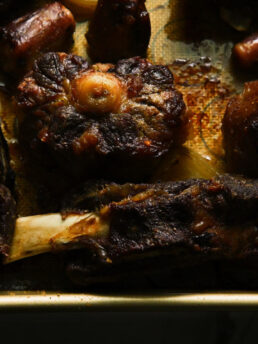
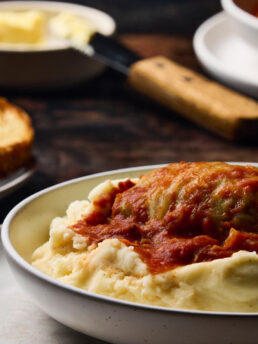
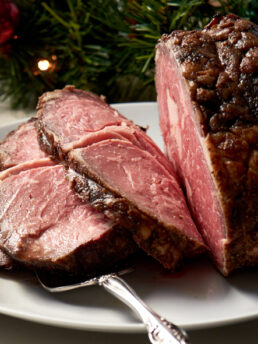
Thanks for the recipe! Chopping the potatoes 2 inches plus buying a potato ricer was a game changer for my mashed potatoes. The recipe turned out amazing and my family loved them!
The pleasure is all mine! Thank you!